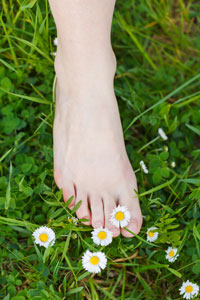Treatments
Diagnosis
An accurate and considered diagnosis is the starting point for the successful treatment of all foot conditions.
A medical history overview is completed to understand how the feet may be affected by other underlying health conditions.
The most suitable treatment can then be selected along with advice to prevent recurrence of the condition.

Callus (Hyperkeratosis)
A Callus is the increased formation and thickening of skin commonly found on the ball of the foot and the heel. They are caused through excessive friction bringing increased blood flow to the region allowing for retention of the outer flattened skin cells.
Calluses may be treated with a file, or pared with a scalpel. The patient maybe also treat themselves to a degree, with an appropriate hand file. Emollient creams and preparations can be advised for suppleness and comfort.

Corns (Latin Cornu – A Horn)
Corns are situated on or between toes or the underside of the feet. They are small regions of dead skin caused by exclusion of their blood supply. Often painful, corns are formed through direct pressure and have many causes, including bad gait and inappropriate footwear.
Generally the most sufficient treatment is removal (enucleation) with a scalpel. Corns return unless the cause is removed or reduced in some way. Healthy Feet Lincs can offer relevant advice specific to the patient, to help prevent or reduce reformation.

Verruca (Human Papilloma Virus)
Verrucas are warts of the foot. The verrucae form by pushing apart the dermal ridges of the skin, and can be painful or have a tingling or burning sensation without pressure actually being applied. The H.P.V. virus is contracted by penetration of the skin through physical contact of the ground, usually in public places such as swimming baths.
Many treatments can be tried, usually freezing or cauterisation (burning) but also by occlusion (saturating the area with moisture so the virus can’t survive) with silver gel, for instance.

Diabetic Feet
Diabetes can cause foot health issues. The two main conditions, Peripheral Artery Disease (PAD) and Peripheral Neuropathy, increase the risk of foot health conditions. With PAD the arteries narrow, limiting the blood supply to the feet, which may cause the slow healing of cuts, and more severe problems such as ulcers. Nerve damage associated with Peripheral Neuropathy can cause symptoms such as numbness, coldness, tingling or burning sensations. Trimming of toenails can require assistance if the patient cannot reach properly and particularly if their sensation is impaired.

In Growing Toenail Treatment
Ingrowing toenails occur when the sides of the toenail grow into the flesh due to various reasons such as poor trimming of the nail, and once the skin is penetrated by the nail the wound cannot heal and pathogens can then enter and infect the toe.
They are acutely painful even before the toe has been infected! The offending slither of nail that is in-growing into the toe needs to be removed before the toe can properly heal, then the area must be cleaned and possibly dressed.

Bio-Mechanic Advice
Biomechanics is the science concerned with the internal and external forces acting on the human body and the effects produced by these forces.
In the context of Foot Health, it relates to the function of the feet, and how the feet affect the function and balance of the whole body.
Problems such as ‘flat feet’ can be alleviated and improved through custom-made othotic insoles and shoe supports which Healthy Feet Lincs is happy to assist and advise on.

Fungal Infections
Athletes Foot (Tinea Pedis).
Symptoms include maceration of the skin between the toes, often accompanied by redness, fissuring and itching, burning sensations. Keratolytic preparations can be used to combat this.
Fungal Toenail Infections (Onychomycosis)
Making up half of nail disorders, this condition causes thickening and discolouration in the nail and can leave the nail bed inflamed and painful. Various topical antifungal treatments can be applied, or in severe cases oral medication can be prescribed.

Other Common Foot Problems
Example sub title
Treatments and advice can also be offered for:
- Nail Cutting
- Plantar Fasciitis
- Chilblains
- Hammer toes
- Gout
- Bunions
- Toe rigidity
- Morton’s Neuroma
- Problematic balance and walking (bad gait)
